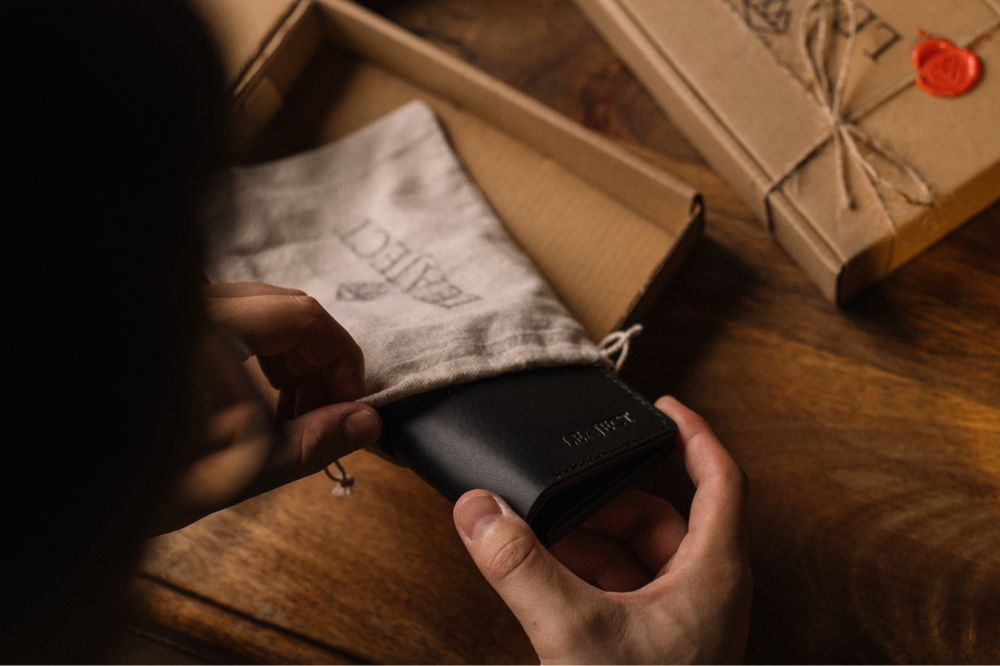How are leather goods created?

Leather is a material that has been used since ancient times and is still popular and remains high in fashion trends to this day. It is an easy-to-use material used in a variety of products such as wallets, shoes, bags, jackets, belts and more. Leather in the form we see in our products is made from animal carcasses and the manufacturing process involves a series of steps designed to transform the raw hide into an easy to use fully usable material. In this article, we will discuss the production process, including the various stages involved and the different methods used until the material comes to the form we see in our various garments and accessories.
1st Phase: Collection of skins
Leather comes from animal carcasses, with the most common sources being cattle, sheep, goats and pigs. The choice of hides for leather production is important as it affects the quality and characteristics of the final product. Factors such as the animal's age, breed, diet and environment can affect the quality and properties of the leather.
Butcher collection is closely linked to the meat industry. When animals are raised for meat consumption, their hides become a valuable by-product that can be used in the leather industry. This connection between the meat and leather industries helps to ensure that hides are not wasted and promotes the efficient use of animal resources.
It is important that leather producers give priority to ethical and sustainable practices in the collection of raw materials. Ethical practices include ensuring that animals are raised and killed in compliance with specifications and regulations, while sustainable practices include minimizing environmental impact. Producers must have full control over the origin of the hides and comply with industry standards.
All of the above not only meet the expectations of socially conscious consumers, but also contribute to the long-term sustainability of the leather industry.
2nd Phase: Soaking, and waxing

After the raw hides are collected, they go through a soaking process to hydrate and prepare them for further processing.
Soaking helps to soften the hides, making them more pliable and easier to process in later stages.
They are usually soaked in water, in large tanks, for a certain period of time. Soaking time may vary depending on factors such as the thickness and condition of the logs.
This is followed by waxing and exfoliation to remove hair and blemishes on the tomes. Hair removal can be done manually or using machines.
In the manual process skilled workers perform the scraping process by hand. They use sharp objects to scrape the coat and flesh, taking great care to maintain an even thickness. Hand sanding requires experience and precision to ensure that the hides are properly prepared for the next steps.
With technological advancement, many factories now use machines for the process, which increases efficiency and productivity. The machines consist of rotating rollers or blades that scrape the hides, removing hair and blemishes in a consistent and controlled manner. In any case the aim is to achieve a clean and smooth surface that is ready for the subsequent stages of tanning and finishing.
The hair and flesh removed during the waxing process are considered by-products and need proper handling. In some cases, hair may be collected and processed separately for other industries such as manufacturing fertilizers or be used in the creation of textile products.
It is worth noting that the specific techniques and equipment used for waxing may vary depending on factors such as factory size, production volume and the desired quality of the finished leather product.
3rd Phase: Separation into sizes and thicknesses

Splitting is the process that involves separating hides into layers and producing different types of hides.
Separation is usually done when needs require different sizes and thicknesses of skin.
The separation process separates the top layer of skin, known as full grain leather, from the lower strata, known as splits.
Full grain leather retains its natural resources and characteristics, making it the most sought after type of leather, used in many leather accessories.
Splits, on the other hand, are a thinner type of leather, more economical, without this of course meaning that they are not used in just as many leather products.
And here there are different ways of separation depending on the desired thickness and skin type.
In manual separation the process is done by human hand, while in other case specialized machines are used to automate the process. The machines can split the hides quickly and consistently, resulting in even layers.
4th Phase: Tempering

Tanning is the process of converting raw hides into usable hides by treating them with tannins or other chemicals to stabilize the collagen fibers and prevent decay. There are two basic processing methods, the herbal and the chromium. Each method has its own characteristics and applications.
Vegetable tanned: This method uses tannins derived from natural sources, such as tree bark (most commonly oak, chestnut, or mimosa), to tan the hides. It is a traditional and time-consuming process, usually lasting several weeks to months. The vegetable tanning treatment results in a durable leather that develops a rich patina over time. This is the top processing method which of course has the corresponding cost.
Chrome tanned: Chromium tanning is a faster and more widespread method that uses chromium salts, usually chromium sulfate, to tan hides. It is a more industrialized process that can be completed within a day or two. It is a more economical but equally reliable solution for this and is preferred by many leather goods producers. This treatment offers flexibility in terms of color, texture and performance characteristics. Over 70% of the market uses this type of leather due to its low cost.
5th Phase: Sanding - Painting - Final Finishing
This is followed by cutting and sanding to perfect the shape, texture and size of the leather.
Sanding usually involves the use of sandpapers and abrasives to create a smooth and polished surface.
Dyeing is the process that allows to achieve a wide range of colors and shades. It involves applying paint to the polished surface while ensuring that the paint will penetrate the leather fibers.
Embossments are also printed on many skins at this stage. Croc print is one of the most well known. In this case, large machines apply pressure and heat to the skin, leaving the pattern in relief.
Finally, the leather receives various finishing coatings to improve its elasticity and offer resistance to moisture, stains and scratches. Finishing can include treatments with oils and creams that can be used to nourish the skin.
6th Phase: Quality control

A very important function for the production of the final product is quality control, which is carried out throughout
Quality control procedures may vary depending on the factory and the type of leather produced. In general, the following steps are followed:
Inspection of raw materials
Raw hides are examined for visible defects or damage. If this is observed, the tomes are rejected from the rest of the process.
In-process inspection
At all stages of leather production, inspections are carried out to ensure that each step is carried out correctly. This includes checking for proper parting, waxing, tanning and finishing processes.
Inspection after the end of production
Skilled workers visually inspect the leather for any defects such as scars, scratches, uneven dyeing, and finishing errors.
Physical tests are then performed to assess the strength, flexibility, tear resistance, color fastness and other relevant properties of the leather. These tests help assess the overall quality and performance of the leather.
Finally, it must be ensured that the characteristics of the skins produced, such as thickness, width and length, meet the specified requirements.
If defects are found during quality control inspections, appropriate corrective action is taken. Depending on the nature and severity of the problem, corrective actions may include reworking the leather, repairing minor defects or, in some cases, discarding it.
In conclusion, the process of creating leather, from the collection of raw materials to the use in products, involves a remarkable journey of expertise and dedication. Each area plays an important role in turning raw hides into highly usable leathers that we use and enjoy in our daily lives.
As consumers, we have the power to make informed choices when it comes to the products we buy. By choosing genuine leather goods, we not only embrace the timeless elegance that leather offers, but also support a rich tradition of craftsmanship.
At Leaject, we are proud to offer a collection of handmade leather goods which are made with passion and love. Our commitment to using genuine leathers sourced from certified factories ensures that you receive the highest quality products possible. From wallets and belts to key rings, accessories and stationery, every item in our collection captures the timeless appeal of genuine leather.
Experience today the lasting charm that leather goods can offer!


